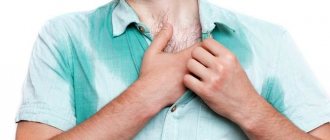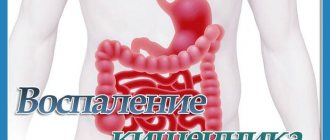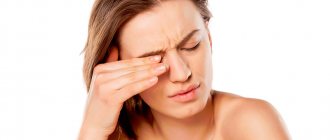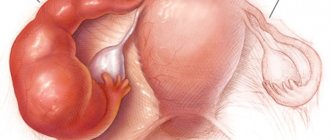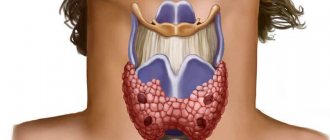Causes of hidradenitis
The disease hidradenitis can appear for the following reasons:
- Scratching the skin for itching caused by allergies or other reasons;
- Using various personal hygiene products and cosmetics that can disrupt the pH of the skin;
- Violation of the hormonal state of the body, which leads to increased sweating;
- The presence of hyperhidrosis, which appears due to prolonged exposure to hot climates, heavy physical activity and stress;
- Ingrown hair into the skin after hair removal;
- The occurrence of diaper rash, which may be caused by improper clothing or failure to comply with personal hygiene rules;
- The use of deodorants and talcum powders, which clog the pores on the skin;
- Incorrect structure of the sweat gland ducts.
Provoking factors
In addition to the main reasons for the development of bitch udders, there are also a number of factors that can trigger the appearance of the disease:
- Damage to the skin.
- Diaper rash formation.
- The body's immunity is under stress.
- Violation of hygiene standards.
- Having problems with the endocrine system.
- Development of obesity.
- The presence of any bacterial infections.
Bitch's udder under the arm
Most often, a bitch udder appears in the armpit area. If you find out the exact cause of the disease, it can be prevented.
The main cause of knotted udders in the armpit is the presence of staphylococci and streptococci. These harmful bacteria initially penetrate the sweat glands and then into the fat cells. After this, inflammation begins in the armpit, which turns into a knotted udder.
One of the types of streptococci - hemolytic - initiates another skin disease - erysipelas of the face.
Symptoms
A pronounced onset of inflammation is not typical for a bitch udder. The disease is gradually increasing in nature.
At the initial stage of the disease, a person develops:
- Severe itching.
- Swelling with painful sensations.
- The swelling has a dense structure.
After some time, the following symptoms begin to develop:
- Increased swelling.
- The swelling acquires a hard structure.
- The pain gets worse.
- The shape of a pear is acquired, and formations appear that look like nipples.
- Skin color becomes burgundy.
At the final stage of development of the bitch udder:
- The inflammation becomes mild.
- From the inflammation, pus with blood is released.
- Body temperature may rise.
- Appearance of weakness.
If treatment is not started in time, the disease can affect other parts of the body that are responsible for sweating. Very often, a knotted udder can be accompanied by sepsis or an abscess . It is for this reason that treatment should occur after the first symptoms of the disease appear.
What does hidradenitis look like under the arm, its main symptoms
Hidradenitis at the initial stage of development.
The appearance of the pathology and physical sensations depend on the stage and severity of the infectious process. Symptoms appear gradually and indicate the transition of the disease to a new phase:
- The initial stage is characterized by the formation of one or more small nodules under the skin. They may itch and itch. During palpation, the patient may experience discomfort.
- The nodes increase in size quite quickly, in about a couple of days, up to a maximum of two centimeters. Each such abscess looks like a dog's nipple with a purple hue.
This is what progressive hidradenitis looks like under the armpit. - The next phase is characterized by severe swelling and a change in the color of the nodes to bluish-burgundy. Simple touches cause severe pain. Temperature may rise to 38 degrees and weakness may occur. Neoplasms can unite and create large inflamed lesions.
- The most unpleasant sensations occur when the abscesses mature. If such a node ruptures on its own, viscous pus appears interspersed with blood. After this, the pain subsides, the wound heals, leaving an ugly scar.
A high body temperature signals the transition of the disease to the maturation period. The occurrence of phlegmon indicates the connection of adipose tissue to the pathological process, and lymphadenitis indicates the inflammatory process of the lymph nodes.
This is what the fistulous form of hidradenitis looks like.
If the disease has become chronic, then two or three fistula openings form in the armpit area.
They are connected by subcutaneous passages and become inflamed from time to time. A fistulous form of the disease occurs. There is a high risk of relapse in obese people and those who suffer from hyperhidrosis.
We recommend that you read:
Causes of excessive armpit sweating; If one armpit sweats more than the other; The smell of sweat has changed - .
Diagnosis of hidradenitis
A bitch udder is quite easy to identify. The specialist must first visually examine the patient and evaluate the location of the inflammatory process, as well as the clinical picture that is characteristic of this disease.
Very often people confuse a knotted udder with a regular boil. However, these diseases have one distinctive feature - necrotic core . Such a rod is typical only for a boil. A bitch's udder can still be very similar to collicative tuberculosis. This disease is characterized by the appearance of severe inflammation of the lymph nodes and the absence of pain.
To visually assess the difference between a boil and a knotted udder, look at the photo of the boil in an article on the topic.
The basis for diagnosing a bitch's udder is a general blood test. If an acceleration of ESR and an increased number of leukocytes are detected in the blood, then this indicates the development of a bitch udder.
If a decision has been made to take antibiotics, then a culture is performed to determine the body’s susceptibility to drugs that are aimed at antibacterial therapy. If the disease has been going on for a long time or appears again, then it is necessary to conduct an immunogram that examines the entire immune system.
Hidradenitis consultation
Question: I have already had hidradenitis in the axillary area twice, at intervals of five months, what should I do? Answer: Understand the reasons. Get examined completely, donate blood for sugar. If you shave this area, use aftershave lotions. Question: Is hidradenitis inherited? Answer: There is no such data. Excessive sweating, obesity, etc., that is, a tendency to this pathology, can be transmitted. Question: Do you need to go to the hospital for hidradenitis? Answer: Most often no. The disease is treated on an outpatient basis, even with surgery. Only then will you need to go for dressings. Hospitalization only in severe cases. Dermatologist Mansurov A.S.
www.medicalj.ru
Bitch udder is a very unpleasant disease. In addition, it can cause serious complications. But these problems can be avoided if you follow certain rules of treatment and prevention.
Moreover, the general condition suffers in the form of intoxication: increased temperature, which can be above 38°C, headache, weakness. It is this moment that is very important to immediately consult a doctor. In this case, a dermatologist or surgeon. If left untreated or self-medicated, serious complications can occur. A very common mistake people make is that during this period they begin to apply heat, thereby dilating the blood vessels and contributing to the spread of infection. Later, fistulas with purulent discharge and scar formation appear.
Treatment
Treatment of bitch udders should be strictly individual for each patient. Moreover, treatment should begin only after a complete examination of the person.
Methods for treating bitch udders:
- If the disease is still at the initial stage , then the patient is prescribed ointments with antibiotics. Most often these are tetracycline and erythromycin. The doctor even prescribes alcohol solutions and hydrogen peroxide in combination. In addition, treatment can be based on ultraviolet irradiation.
- If the disease has already developed before the formation of pus , then the formation itself is opened and drained. This procedure is not very complicated, so you should not be afraid of such an operation. After this, the patient is prescribed antibiotics in the form of ciprofloxacin and azitrox.
- If the disease occurs at an active stage , then the formations cannot be wetted. In addition, you should exclude all sweet and spicy foods, as well as alcoholic drinks, from your diet. After the disease is cured, it is necessary to eliminate all factors that could provoke the formation of the disease again.
In order to stimulate the purulent contents out of the inflammation, it is smeared with Vishnevsky's liniment or ichthyol ointment. First, you need to cut off all the hair from the site of inflammation, then apply the ointment in a very thin layer over the painful formation. These ointments have stretching properties, so they are also used to quickly form the core of a boil. See a photo of the boil here.
Next, the inflammation must be covered with a sterile bandage. This dressing must be changed at least three times a day or when it becomes dirty. With each replacement, the inflammation must be smeared again.
After the purulent contents are released, the following means must be used:
- antibiotic ointment Levomekol.
- Clindamycin solution lotions.
- Compress from a solution of dimexide and iodine.
- Oflomelid.
Antibiotics
Treatment must be comprehensive, therefore, in addition to ointments, it is necessary to take antibiotics.
Most often, the following antibiotics are prescribed for the treatment of bitch udders:
- Erythromycin – 4 times a day.
- Tetracycline – once a day.
- Minocycline – 3 times a day.
Physiotherapy
Physiotherapy aimed at treating bitch udders includes the following procedures:
- Bactericidal technique
- Anti-inflammatory therapy using UHF, SUV irradiation
- Immunostimulating therapy (laser blood irradiation, magnetic therapy, heliotherapy)
- Regenerative technique
Folk remedies
Many doctors say that treating bitch udders with traditional methods is an ineffective method, however, it cannot cause harm to health and can be combined well with drug therapy. In addition, reviews from people indicate that folk remedies can easily combat this disease.
Features of therapy for hidradenitis
In advanced cases, surgical intervention is required to eliminate purulent formation. To avoid this, it is important to consult a specialist at the first symptoms of the disease and begin proper treatment.
First of all, with such a diagnosis, the attending physician will prescribe taking antibacterial agents that will directly fight the causative agent of inflammation. It would also be appropriate to use anti-inflammatory drugs in a comprehensive manner, which will simultaneously reduce pain and swelling in the affected area.
Under no circumstances should you try to speed up the process of maturation of the abscess or squeeze it out yourself. This can only lead to the problem getting worse and the infection spreading. If you neglect this warning, you may even get blood poisoning and die.
When it is not possible to urgently seek qualified medical help, the first action is to apply a bandage with Vishnevsky ointment. You can also dilute ethyl alcohol in a 1:1 ratio with water and apply it to the sore spot.
If a hole appears in the area where the nodule is formed, from which pus flows, this process should not be accelerated. It is enough just to disinfect the area with alcohol or another antibacterial compound.
In cases where the use of drugs does not produce results, doctors may decide to perform surgery. In the process of removing an abscess, tissue that has undergone necrosis and infection is excised. However, after surgery you should not stop taking antibiotics. It is important to complete the full course, otherwise the disease may recur.
Postoperative care includes regular dressing changes and the application of medicinal ointments. As a rule, the dressing should be changed at least every two days.
Prevention
In order to avoid hidradenitis, you must also follow a few simple preventive rules:
- Maintaining cleanliness and personal hygiene.
- Experts strongly recommend not wearing tight clothes. Tight clothing often causes irritation on the skin.
- The armpits should be kept clean at all times.
- If any deodorants or cosmetics cause inflammation on the skin, then it is better not to use it. It is these preventive norms that can prevent the occurrence of the disease.
Stories from our readers!
“For a long time I experienced discomfort from dandruff and hair loss. Standard shampoos helped, but the effect was short-term. This complex was recommended by a friend who used it herself. Excellent tool!
The skin stopped itching, the hair combed well and was not so greasy. The loss stopped fairly quickly. I couldn’t even dream of such an effect! I recommend."
Hidradenitis or “bitch udder”: how to cure it at home
What it is
Hidradenitis is a pathology of the sweat glands caused by an inflammatory process. The most common causative agent of infection is Staphylococcus aureus. The disease can be chronic.
According to the location they are distinguished:
in the armpit area;
and hidradenitis pilaris (in men).
The neck, face and mucous membranes are affected in rare cases.
Women who have reached puberty are most susceptible to the disease. The etiology of hidradenitis is quite simple: a bacterial infection enters the mouth of the hair follicle through a wound on the skin . At this stage, you can see a small pimple or abscess, a little painful, possibly with a pus cap. As the infection grows, pathogenic microorganisms penetrate the sweat glands and provoke an increase in foci of infection.
There are several stages in the development of a bitch udder:
Redness and pain on palpation.
The appearance of red boils.
Spontaneous opening of abscesses, appearance of purulent discharge.
Often, patients take only local treatment methods - all sorts of lotions and creams, which allows them to forget about the problem for a while . But soon after a slight remission and the scarring stage, the wolf's udder appears again and all stages of the disease are repeated.
With proper treatment, the pathology can be eliminated within 5-7 days.
But, oddly enough, people who have been tormented by a bitch’s udder for several years turn to doctors. This statistics is due to the fact that in our country the system of self-diagnosis and self-medication is very “developed” . In the early stages, a knotted udder can be confused with furunculosis, folliculitis and a number of other skin pathologies. Due to improper treatment, the disease begins to progress and scars appear.
Hidradenitis in an uncomplicated form does not bring much discomfort to the patient, except for an obvious cosmetic defect. But as inflammation increases, crusting, tissue damage, and sepsis may occur.
Signs of hidradenitis or how to distinguish knot udder from other skin diseases
Hidradenitis of the axilla is localized mainly in the area of only one armpit. In some cases (complicated by concomitant chronic diseases), lesions appear on two armpits and in the folds of the mammary glands.
At the infection stage, the nodules have the red shape of inflamed pimples. They itch when sweating and are painful on palpation. Unlike furunculosis, hidradenitis extremely rarely appears on the face and in the shoulder girdle. In places where there are no sweat glands or hair, hidradenitis appears as a concomitant dermatological phenomenon.
The udder is pea-shaped and has a blue-red hue for a long time (with furunculosis, pimples with a purulent cap, small). Unlike folliculitis, hidradenitis does not affect the scalp . At the second stage, the knotted udder has a pronounced round shape and is very painful. Several lesions can merge into one.
At the maturation stage, the patient experiences general weakness, pain at the site of inflammation, fever and other signs of infection. At the third stage, the nodules begin to soften, become less painful and open.
Opened lesions can fester for several days, and serous fluid with blood fragments may be released. Thick purulent masses have an unpleasant, pungent putrefactive odor. As soon as the discharge from the wound ends, it heals. In patients with the chronic form, new lesions and ulcers appear next to the scars, which later heal.
Causes of hidradenitis
Hidradenitis is classified as one of the forms of pyoderma (bacterial infections that cause pustular lesions of the skin). Pathogenic microorganisms can be introduced after shaving, combing, or squeezing pimples . Hidradenitis in the armpits in women is common, since this area of skin is subject to frequent destruction during hair removal, and sweating increases the number of bacteria.
The occurrence and development of infection can be influenced by a number of factors; triggers for the disease can be:
high degree of sweating;
previous dermatological diseases;
working conditions that do not meet sanitary standards;
wearing dirty underwear;
frequent use of products that mask the smell of sweat;
wearing tight synthetic underwear;
In people with normal immune functions, hidradenitis resolves within a week or two with the use of oral antibacterial drugs and local external ointments.
The complicated form is accompanied by the constant appearance of weeping ulcers, scarring, and an unpleasant odor. The long course of hidradenitis, which cannot be treated with drugs of choice, indicates concomitant pathologies.
Diseases that make it difficult to get rid of a bitch's udder:
What is hidradenitis
Hidradenitis is an inflammatory process that occurs in the sweat glands, called apocrine glands , which do not participate in thermoregulation processes . They produce a secretion that is quite viscous and sticky in structure with a pungent odor. These glands are not located throughout the body, like eccrine glands, but in certain areas. The places where they are localized are the armpits, as well as the parotid, genital, perianal, perineal, parapapillary areas, the area under the mammary glands and the popliteal fossa.
The excretory ducts of the apocrine glands exit near the hair shaft
It is believed that these secretions are responsible for behavioral reactions, especially sexual desire. They contain special hormone-dependent substances - pheromones, which are characterized by their individuality (no people have the same composition), attract (or repel) people of the opposite sex, are responsible for the emotional state of a person and his environment, and regulate the processes of reproduction. In addition, this secretion contains a large amount of fatty acids and cholesterol, giving it a thick consistency. The increased “odor” of such sweat appears when many different bacteria intensively multiply in it. It happens that they get inside the gland or its duct, as a result of which inflammation begins.
One of the main features of the pathology is that it never occurs in elderly and senile people, as well as in young children. This is due to the fact that at an early age the apocrine glands are not fully formed, and their functioning begins during puberty (at about twelve to fifteen years), and already at an older age their activity gradually fades away, and the ability to secrete secretions is lost.
Causes of hidradenitis
Most often, inflammation of the sweat glands is diagnosed in women 30–40 years old with a history of various gynecological diseases. People with diabetes, people who are obese or who neglect personal hygiene are at risk. Hidradenitis in children is extremely rare and only occurs with insufficient care for the baby.
What causes hidradenitis? It is generally accepted that the main cause of inflammation is Staphylococcus aureus, which, under unfavorable conditions, penetrates the mouth of the sweat glands and causes inflammation.
Predisposing factors are:
- reducing skin acidity;
- hormonal disorders;
- puberty;
- allergic dermatoses;
- exacerbation of chronic diseases;
- weakening of general immunity;
- excessive sweating;
- diaper rash;
- stress.
Another cause of hidradenitis is considered to be a hereditary factor. There have been cases of familial anomalies in the structure of the sweat glands, when their mouths are too short and wide, which facilitates the penetration of the pathogen.
Hidradenitis during pregnancy develops against the background of hormonal changes in the body. Endocrine processes shift the pH of the skin to the alkaline side, weaken the local immunity of the dermis and provoke inflammation of the sweat glands.
Causes
The causes of hidradenitis, like any infectious process, include two factors - micro- and macroorganism. The disease belongs to the group of staphylococcal pyoderma, that is, it is caused by a variety of staphylococci, even normally populating the surface of the skin, for example, staphylococcus epidermidis. But, nevertheless, most often hidradenitis is caused by Staphylococcus aureus or hemolytic Staphylococcus, which is widespread in the environment. This microorganism secretes coagulase, an enzyme that causes blood clotting in the microvessels surrounding the inflammation, so the infection does not spread under the skin, but forms a limited abscess with a tendency to open.
Sometimes the cause of hidradenitis is an association of bacteria, which, in addition to staphylococcus, may include:
- coli;
- Proteus;
- Klebsiella
Factors that promote the proliferation of staphylococcus in the sweat gland are increased skin moisture, increased blood supply and development of sweat glands during puberty, diabetes, pollution and trauma. Thus, women often develop hidradenitis inguinalis after poor-quality depilation performed by shaving.
The infection enters the gland either through an enlarged lumen or through microscopic scratches and damage to the skin. Axillary hidradenitis is more common, and inguinal hidradenitis is less common.
Symptoms of hidradenitis
In the first days, the patient notices the appearance of one or more itchy subcutaneous formations, painful when pressed. Acute hidradenitis develops very quickly - already on the 3rd day the swelling grows to several centimeters in diameter, becomes dense and hot to the touch, the dermis above it turns red and swells.
Gradually, the center of the infiltrate softens and after 10–12 days it opens, releasing a large amount of pus. Hidradenitis ends with the formation of a scar. If nearby sweat glands are involved in the inflammatory process, an extensive abscess forms at the site of the lesion. In this case, the disease drags on for 1–1.5 months.
A bitch udder is often accompanied by symptoms of general intoxication of the body:
- fever;
- apathy and weakness;
- loss of appetite;
- sleep disturbance;
- headache;
- nausea, vomiting;
- general malaise.
After opening the abscess, the patient’s well-being improves significantly, the signs of hidradenitis disappear, and the disease enters the final stage.
In people with reduced immunity, disruption of the endocrine system, or those suffering from excessive sweating, hidradenitis often becomes chronic with frequent relapses. In this case, several foci of inflammation are observed at different stages of development.
Stages of the disease and their corresponding symptoms
The initial stage of the disease is the penetration of infectious agents into the sweat gland duct. As a result of their increased reproduction and disruption of the processes of desquamation of the surface epithelium, the release of secreted fluid is first disrupted, and then completely stops due to blockage of the outlet. Gradually, secretions accumulate inside the duct, contributing to its gradual expansion. At this stage, you can detect a small lump deep under the skin or a visible bump without changing the color of the skin.
As it develops, the lump gradually begins to swell, itch, and then turn red, while pain in the localized areas increases every day, becoming more and more intense. This is the active phase of inflammation. In addition, the patient has an increased temperature from low-grade to high (from 37.5 to 39–40 oC), increased weakness, drowsiness and lethargy are observed, dizziness, headaches and nausea are possible.
Then the abscess breaks through, and its contents come out. The bacteria contained in its composition fall on clean skin, penetrating into the healthy ducts of the glands. Then history repeats itself. Thus, more and more new areas are involved in the process. The tissues become swollen and acquire a bluish-purple tint. Abscesses merge with each other, increasing in size and hanging over the surface of healthy skin. It is thanks to its appearance that the disease is popularly called “bitch udder”.
Sometimes the ulcers reach enormous sizes. It is known that a pathological formation larger in diameter than a goose egg has been removed.
Which doctor treats hidradenitis?
At the first signs of hidradenitis, you should consult a dermatologist. If the inflammatory process is complicated by the appearance of pus, fever, headache and a sharp deterioration in health, it is necessary to visit a surgeon.
If there are frequent exacerbations of hidradenitis, it would not hurt to postpone a visit to an endocrinologist or immunologist to rule out endocrine causes or immunodeficiency. If these specialists are not on staff at the city clinic, it is recommended to make an appointment with a therapist or general practitioner.
Diagnostics
It is not difficult to recognize a disease such as hidradenitis. Initial diagnosis is based on an initial examination of the patient with an assessment of the typical symptoms of inflammation of the sweat glands. One of the hallmarks of hidradenitis is the absence of a necrotic core.
To clarify the diagnosis, the doctor prescribes a general blood test. With inflammation, there is an increase in the number of leukocytes and ESR. In the case of a chronic form, accompanied by multiple foci, the patient undergoes an ultrasound. The procedure allows you to determine the location of all infiltrates and facilitates the surgeon’s work.
When diagnosed with hidradenitis, bacterial culture is often performed. The study helps to find out which pathogen provoked the inflammatory process and select the optimal antibiotic.
Differential diagnosis
To prescribe adequate treatment for hidradenitis, a method of differential diagnosis should be used with a furuncle, carbuncle, lymphadenitis and felinosis in the early stages of the disease, and lymphogranuloma venereum, donovaz, scrofuloderma and actinomycosis in the later stages of the disease.
Rice. 11. The photo shows an enlarged lymph node in the armpit (left) and a boil (right).
Treatment of hidradenitis
How to treat a bitch udder? In the first days, until hidradenitis becomes purulent, it can be treated with local remedies. At later stages, the use of antibacterial drugs is required. All necessary medications are prescribed only by the attending physician. He also calculates the dosage and frequency of use.
Antibiotics for hidradenitis
Ointments and oral antibiotics will help fight hidradenitis. Moreover, antimicrobial drugs are considered more effective compared to local agents. They allow you to eliminate all the symptoms of the disease in 8–10 days and significantly reduce the risk of complications.
The following antibiotics are used to treat hidradenitis:
Antibiotics for hidradenitis are most often taken orally, but for acute inflammation, the doctor may prescribe intramuscular injections.
How to cure a chronic form of the disease? For frequently recurring relapses, the patient is administered staphylococcal immunoglobulin, T-activin, Anatoxin or Antifagin. In the same case, the use of immunostimulants is indicated: tinctures of Eleutherococcus, Echinacea, ginseng.
Hidradenitis should be treated especially carefully during pregnancy. During this period, the use of many medications is contraindicated, so preference is given to anti-inflammatory and antibacterial ointments. In case of urgent need, the doctor prescribes Clindamycin or Amoxiclav.
Ointments for hidradenitis
How to get rid of bitch udders using local remedies? Treatment of hidradenitis with ointments is effective at all stages of the disease. In addition, such medications are indispensable in the postoperative period and are completely safe for pregnant and nursing mothers, since they are not absorbed into the bloodstream and cannot affect the child.
Vishnevsky ointment, Levomekol and Baneocin are very effective for hidradenitis. The products help to break through the purulent lump, have an antiseptic, antimicrobial and anti-inflammatory effect, and accelerate tissue regeneration. Ichthyol ointment gives the same effect. To make the abscess ripen faster, it is covered with ichthyol and protected with a gauze cloth. The dressing is changed once a day
After the infiltrate has broken through, Baneocin is used. The medication is a local antibacterial agent and is considered less harmful than oral medications, so it can even be used to treat a child. Baneocin is available in the form of powder and ointment for external use.
Separate mention should be made of Dimexide (Dimethyl sulfoxide). The drug penetrates deeply into the affected tissue, eliminates pain and inflammation, and also enhances the effect of other medications. Dimexide is produced in the form of a liquid for cutaneous use and a gel in aluminum tubes.
Lierak products can be used as an aid for hidradenitis.
Removing the bitch's udder
If the suppurating infiltrate does not break through on its own or there is a risk of blood poisoning, surgery comes to the rescue. Surgery is also required for recurrent hidradenitis.
The single abscess is opened under local anesthesia, the wound surface is cleaned of pus and disinfected with an antiseptic solution. The procedure takes no more than 20 minutes and is performed on an outpatient basis. If hidradenitis constantly recurs, the doctor excises the affected gland, eliminates fistulas and fibrous nodes. This procedure is performed under general anesthesia in a hospital.
For postoperative treatment of the wound, Baneocin is used, applying it under a gauze pad. Dressings are done daily until the tissues are completely healed.
Physiotherapy
Physiotherapy will help cure a knotted udder without suppuration. The following procedures are useful for hidradenitis:
For recurrent inflammation, the doctor may prescribe x-ray therapy, but only in the absence of exudative cavities.
Herbs and plants for hidradenitis
Treatment of hidradenitis with any means of traditional medicine, including herbs, has two goals:
- providing antibacterial therapy when taking drugs orally;
- local relief of symptoms.
An infusion of calendula, wild hops, elderberry, eucalyptus and plantain has a good anti-inflammatory and antibacterial effect. All dried ingredients must be taken 1 tbsp. l., chop and pour 0.5 l of boiling water. After keeping in a water bath for 15 minutes, the infusion must be cooled and strained. Take 50 ml three times a day.
An infusion of string and lingonberry leaves also works well against pathogenic bacteria. They need to be taken 1 tbsp. l. and pour 0.4 liters of boiling water, let it brew for an hour and strain. Take 50 ml 4 times a day 30 minutes before meals.
You can also use a decoction consisting of two parts blackberry leaves and one part calendula flowers. To prepare it, 1 tbsp. l. vegetable raw materials need to be poured with 200 ml of boiling water and simmer over low heat for 30 minutes. After cooling and straining, take a decoction of 50 ml 3-4 times a day.
To relieve painful sensations, you can prepare the following herbal lotions:
Plantain juice. Squeeze the juice from fresh crushed leaves of the plant and wet a sterile bandage with it. Apply the product to the affected area until completely dry three times a day.
- A decoction of chamomile, eucalyptus and sage. For 1 tbsp. l. vegetable raw materials, you need to take 200 ml of boiling water and cook over low heat for 30 minutes. After straining the cooled broth, moisten the bandage and leave it on the inflamed areas of the skin for 20 minutes, providing dry heat on top. You can make such lotions up to 8 times a day with an interval of 2 hours.
- Infusion of horsetail herb. To prepare it you should take 1 tbsp. l. dried crushed raw materials and pour 200 ml of boiling water. Let it brew for 1 hour, then strain and use for lotions three times a day.
Complications
Without competent and timely measures, hidradenitis suppurativa is often complicated by lymphadenitis, sepsis or phlegmon. To avoid such consequences, you should not self-medicate.
If the infiltrate cannot be opened within 10–12 days, it is necessary to urgently contact a surgeon, and not wait for further deterioration of health. During the lost time, new foci of hidradenitis will appear, connected to each other by fistulas (channels). Treatment in this case will be long and difficult.
Prevention
The main prevention of hidradenitis is compliance with the rules of personal hygiene:
- taking regular baths or showers;
- daily change of underwear;
- wearing clothes made from natural fabrics;
- use of detergents with a neutral reaction without fragrances;
- periodic treatment of areas prone to inflammation with antiseptics;
To prevent hidradenitis, it is necessary to strengthen the immune system, fight extra pounds and promptly eliminate foci of infection.
After treating a bitch udder, it is very important to prevent the disease from reoccurring. To do this, the doctor will advise periodically applying Baneocin to the affected areas or treating them with an antiseptic.
Hidradenitis is a serious pathology that, if not treated correctly, leads to serious complications. If itchy and painful bumps appear in places where skin secretion glands accumulate, you should consult a doctor. Self-medication for this disease is unacceptable.
Signs of hidradenitis (bitch udder)
At the very beginning, a small subcutaneous node appears, causing only minor discomfort to the person. Then the knot increases, new abscesses begin to appear, the diameter of which is about one centimeter, in appearance it is very reminiscent of an udder. In more severe cases, when the abscesses grow, they merge into one large abscess, causing unbearable pain to the patient, limiting his movement, forcing him to take uncomfortable forced positions, and take care of the affected area. Other signs may include general weakness and increased body temperature. Over time, the ulcers can open up on their own and release pus and blood.
